Irrigation Protocols in Different Water Availability Scenarios for ‘Crimson Seedless’ Table Grapes under Mediterranean Semi-Arid Conditions
Abstract
1. Introduction
2. Material and Methods
2.1. Study Area, Weather Conditions and Irrigation Treatments
2.2. Measurements
2.3. Model Algorithm
3. Results
3.1. Agrometeorological Variables, Irrigation Water Applied and Plant Water Status
3.2. Reproductive and Vegetative Patterns
3.3. Berry Quality Patterns
3.4. Predictive Model
4. Discussion
5. Conclusions
Author Contributions
Funding
Institutional Review Board Statement
Informed Consent Statement
Data Availability Statement
Acknowledgments
Conflicts of Interest
References
- Williams, L.E.; Phene, C.J.; Grimes, D.W.; Trout, T.J. Water use of mature Thompson Seedless grapevines in California. Irrig. Sci. 2003, 22, 11–18. [Google Scholar] [CrossRef]
- Pérez-Pastor, A.; Ruiz-Sánchez, M.C.; Conesa, M.R. Drought stress effect on woody tree yield. In Water Stress and Crop Plants: A Sustainable Approach; John Wiley & Sons, Ltd.: London, UK, 2016; pp. 356–374. ISBN 978-1-119-05445-0. [Google Scholar]
- Ruiz-Sánchez, M.C.; Domingo, R.; Castel, J. Review. Deficit irrigation in fruit trees and vines in Spain. Span. J. Agric. Res. 2010, 8. [Google Scholar] [CrossRef]
- Chai, Q.; Gan, Y.; Zhao, C.; Xu, H.-L.; Waskom, R.M.; Niu, Y.; Siddique, K.H.M. Regulated deficit irrigation for crop production under drought stress. A review. Agron. Sustain. Dev. 2015, 36, 3. [Google Scholar] [CrossRef]
- Medrano, H.; Tomás, M.; Martorell, S.; Escalona, J.-M.; Pou, A.; Fuentes, S.; Flexas, J.; Bota, J. Improving water use efficiency of vineyards in semi-arid regions. A review. Agron Sustain. Dev. 2015, 35, 499–517. [Google Scholar] [CrossRef]
- Chalmers, D.J.; Mitchell, P.D.; Van Heek, L. Control of peach tree growth and productivity by regulated water supply, tree density, and summer pruning [Trickle irrigation]. J. Am. Soc. Hortic. Sci. 1981, 106, 307–312. [Google Scholar]
- Dry, P. Effects of partial root-zone drying on grapevine vigour, yield, composition of fruit and use of water. In Proceedings of the Ninth Australian Wine Industry Technical Conference; Winetittles: Adelaide, Australia, 1996. [Google Scholar]
- MAPA-España Ministerio de Agricultura, Pesca y Alimentación. Available online: https://www.mapa.gob.es/es/ (accessed on 22 October 2020).
- Conesa, M.R.; de la Rosa, J.M.; Artés-Hernández, F.; Dodd, I.C.; Domingo, R.; Pérez-Pastor, A. Long-term impact of deficit irrigation on the physical quality of berries in “Crimson Seedless” table grapes. J. Sci. Food Agric. 2015, 95, 2510–2520. [Google Scholar] [CrossRef]
- Faci, J.M.; Blanco, O.; Medina, E.T.; Martínez-Cob, A. Effect of post veraison regulated deficit irrigation in production and berry quality of Autumn Royal and Crimson table grape cultivars. Agric. Water Manag. 2014, 134, 73–83. [Google Scholar] [CrossRef]
- Río Segade, S.; Giacosa, S.; Torchio, F.; de Palma, L.; Novello, V.; Gerbi, V.; Rolle, L. Impact of different advanced ripening stages on berry texture properties of ‘Red Globe’ and ‘Crimson Seedless’ table grape cultivars (Vitis vinifera L.). Sci. Hortic. 2013, 160, 313–319. [Google Scholar] [CrossRef]
- Ferrara, G.; Mazzeo, A.; Matarrese, A.M.S.; Pacucci, C.; Pacifico, A.; Gambacorta, G.; Faccia, M.; Trani, A.; Gallo, V.; Cafagna, I.; et al. Application of Abscisic Acid (S-ABA) to ‘Crimson Seedless’ Grape Berries in a Mediterranean Climate: Effects on Color, Chemical Characteristics, Metabolic Profile, and S-ABA Concentration. J. Plant. Growth Regul. 2013, 32, 491–505. [Google Scholar] [CrossRef]
- Fernandes de Oliveira, A.; Nieddu, G. Deficit Irrigation Strategies in Vitis vinifera L. cv. Cannonau under Mediterranean Climate. Part II -Cluster Microclimate and Anthocyanin Accumulation Patterns. South Afr. J. Enol. Vitic. 2013, 34, 184–195. [Google Scholar] [CrossRef]
- Pinillos, V.; Chiamolera, F.M.; Ortiz, J.F.; Hueso, J.J.; Cuevas, J. Post-veraison regulated deficit irrigation in ‘Crimson Seedless’ table grape saves water and improves berry skin color. Agric. Water Manag. 2016, 165, 181–189. [Google Scholar] [CrossRef]
- Williams, L.E.; Matthiews, M.A. Grapevine. In Irrigation of Agricultural Crops; Agronomy Monograph No. 30; American Society of Agronomy, Crop Sciences Society of America and the Soil Science Society of America: Madison, WI, USA, 1990; pp. 1019–1055. ISBN 0-89118-102-4. [Google Scholar]
- Fereres, E.; Soriano, M.A. Deficit irrigation for reducing agricultural water use. J. Exp. Bot. 2007, 58, 147–159. [Google Scholar] [CrossRef] [PubMed]
- Williams, L.E.; Grimes, D.W.; Phene, C.J. The effects of applied water at various fractions of measured evapotranspiration on water relations and vegetative growth of Thompson Seedless grapevines. Irrig. Sci. 2010, 28, 221–232. [Google Scholar] [CrossRef]
- Vita Serman, F.; Liotta, M.; Parera, C. Effects of irrigation deficit on table grape cv. Superior Seedless production. Acta Hortic. 2004, 646, 183–186. [Google Scholar] [CrossRef]
- Permanhani, M.; Costa, J.M.; Conceição, M.A.F.; de Souza, R.T.; Vasconcellos, M.A.S.; Chaves, M.M. Deficit irrigation in table grape: Eco-physiological basis and potential use to save water and improve quality. Theor. Exp. Plant. Physiol. 2016, 28, 85–108. [Google Scholar] [CrossRef]
- Conesa, M.R.; Falagán, N.; de la Rosa, J.M.; Aguayo, E.; Domingo, R.; Pastor, A.P. Post-veraison deficit irrigation regimes enhance berry coloration and health-promoting bioactive compounds in “Crimson Seedless” table grapes. Agric. Water Manag. 2016, 163, 9–18. [Google Scholar] [CrossRef]
- Allen, R.G.; Pereira, L.S.; Raes, D.; Smith, M. Crop Evapotranspiration. FAO 56; FAO: Roma, Italy, 1998. [Google Scholar]
- SIAM Sistema de Información Agrario de Murcia. Available online: http://siam.imida.es (accessed on 21 October 2020).
- SCRATS Sindicato Central de Regantes del Acueducto Tajo-Segura. Available online: http://www.scrats.es (accessed on 21 October 2020).
- Hsiao, T.C. Measurements of plant water status. Agronomy 1990, 30, 243–279. [Google Scholar]
- Myers, B.J. Water stress integral—a link between short-term stress and long-term growth. Tree Physiol. 1988, 4, 315–323. [Google Scholar] [CrossRef]
- Richardson, E.A.; Seeley, S.D.; Walker, D.R.; Anderson, J.L.; Ashcroft, G.L. Pheno-climatography of spring peach bud development. HortScience 1975, 10, 236–237. [Google Scholar]
- Parker, A.K.; Garcia de Cortazar-Atauri, I.; van Leeuwen, C.; Chuine, I. General phenological model to characterise the timing of flowering and veraison of Vitis vinifera L. Aust. J. Grape Wine Res. 2011, 17, 206–216. [Google Scholar] [CrossRef]
- Pérez-Pastor, A.; Ruiz-Sánchez, M.C.; Domingo, R. Effects of timing and intensity of deficit irrigation on vegetative and fruit growth of apricot trees. Agric. Water Manag. 2014, 134, 110–118. [Google Scholar] [CrossRef]
- Rasmussen, C.E.; Williams, C.K.I. Gaussian Processes for Machine Learning; Adaptive computation and machine learning; MIT Press: Cambridge, MA, USA, 2006; ISBN 978-0-262-18253-9. [Google Scholar]
- Williams, L.E.; Ayars, J.E. Grapevine water use and the crop coefficient are linear functions of the shaded area measured beneath the canopy. Agric. For. Meteorol. 2005, 132, 201–211. [Google Scholar] [CrossRef]
- Silva-Contreras, C.; Schouwen, G.; Ferreyra-Espada, R.; Silva, H. Variation of water potential and trunk diameter answer as sensitivity to the water availability in table grapes. Chil J. Agric. Res. 2012, 72, 459–469. [Google Scholar] [CrossRef]
- Vox, G.; Schettini, E.; Scarascia, G.; Tarricone, L.; Gentilesco, G. Crimson Seedless table grape grown under plastic film: Ecophysiological parameters and grape characteristics as affected by the irrigation volume. In Proceedings of the International Conference of Agricultural Engineering—AgEng 2014—Engineering for Improving Resource Efficiency; The European Society of Agricultural Engineers: Zurich, Switzerland, 2014. [Google Scholar]
- Blanco Alibes, O.; Faci, J.; Negueroles, J. Response of table grape cultivar “Autumn Royal” to regulated deficit irrigation applied in post-veraison period. Span. J. Agric. Res. 2010, 8. [Google Scholar] [CrossRef]
- Ferreyra, R.; Selles, G.; Silva, H.; Ahumada, R.; Muñoz, I.; Muñoz, V. Effect of applied water on water relations and productivity of “Crimson Seedless” table grapes. Pesqui. Agropecu. Bras. 2006, 41, 1109–1118. [Google Scholar] [CrossRef]
- Pérez-Pastor, A.; Domingo, R.; Torrecillas, A.; Ruiz-Sánchez, M.C. Response of apricot trees to deficit irrigation strategies. Irrig. Sci. 2009, 27, 231–242. [Google Scholar] [CrossRef]
- Çolak, Y.; Yazar, A. Evaluation of crop water stress index on Royal table grape variety under partial root drying and conventional deficit irrigation regimes in the Mediterranean Region. Sci. Hortic. 2017, 224, 384–394. [Google Scholar] [CrossRef]
- Conesa, M.R.; Dodd, I.C.; Temnani, A.; De la Rosa, J.M.; Pérez-Pastor, A. Physiological response of post-veraison deficit irrigation strategies and growth patterns of table grapes (cv. Crimson Seedless). Agric. Water Manag. 2018, 208, 363–372. [Google Scholar] [CrossRef]
- Boini, A.; Manfrini, L.; Bortolotti, G.; Corelli-Grappadelli, L.; Morandi, B. Monitoring fruit daily growth indicates the onset of mild drought stress in apple. Sci. Hortic. 2019, 256, 108520. [Google Scholar] [CrossRef]
- Naor, A. Irrigation and Crop Load Influence Fruit Size and Water Relations in Field-grown “Spadona” Pear. J. Am. Soc. Hortic. Sci. 2001, 126. [Google Scholar] [CrossRef]
- Naor, A.; Hupert, H.; Greenblat, Y.; Peres, M.; Kaufman, A.; Klein, I. The Response of Nectarine Fruit Size and Midday Stem Water Potential to Irrigation Level in Stage III and Crop Load. J. Am. Soc. Hortic. Sci. 2001, 126. [Google Scholar] [CrossRef]
- Jones, H. Monitoring plant and soil water status: Established and novel methods revisited and their relevance to studies of drought tolerance. J. Exp. Bot. 2007, 58, 119–130. [Google Scholar] [CrossRef] [PubMed]
- Shackel, K.A.; Ahmadi, H.; Biasi, W.; Buchner, R.; Goldhamer, D.; Gurusinghe, S.; Hasey, J.; Kester, D.; Krueger, B.; Lampinen, B.; et al. Plant water status as an index of irrigation need in deciduous fruit trees. Horttechnology 1997, 7, 23–29. [Google Scholar] [CrossRef]
- Abrisqueta, I.; Conejero, W.; Valdés-Vela, M.; Vera, J.; Ortuño, M.F.; Ruiz-Sánchez, M.C. Stem water potential estimation of drip-irrigated early-maturing peach trees under Mediterranean conditions. Comput. Electron. Agric. 2015, 114, 7–13. [Google Scholar] [CrossRef]
- Naor, A.; Naschitz, S.; Peres, M.; Gal, Y. Responses of apple fruit size to tree water status and crop load. Tree Physiol. 2008, 28, 1255–1261. [Google Scholar] [CrossRef]
- Lakso, A.N.; Grappadelli, L.C.; Barnard, J.; Goffinet, M.C. An expolinear model of the growth pattern of the apple fruit. J. Hortic. Sci. 1995, 70, 389–394. [Google Scholar] [CrossRef]
- Verrelst, J.; Muñoz, J.; Alonso, L.; Delegido, J.; Rivera, J.P.; Camps-Valls, G.; Moreno, J. Machine learning regression algorithms for biophysical parameter retrieval: Opportunities for Sentinel-2 and -3. Remote Sens. Environ. 2012, 118, 127–139. [Google Scholar] [CrossRef]
- Yin, G.; Verger, A.; Qu, Y.; Zhao, W.; Xu, B.; Zeng, Y.; Liu, K.; Li, J.; Liu, Q. Retrieval of High Spatiotemporal Resolution Leaf Area Index with Gaussian Processes, Wireless Sensor Network, and Satellite Data Fusion. Remote Sens. 2019, 11, 244. [Google Scholar] [CrossRef]
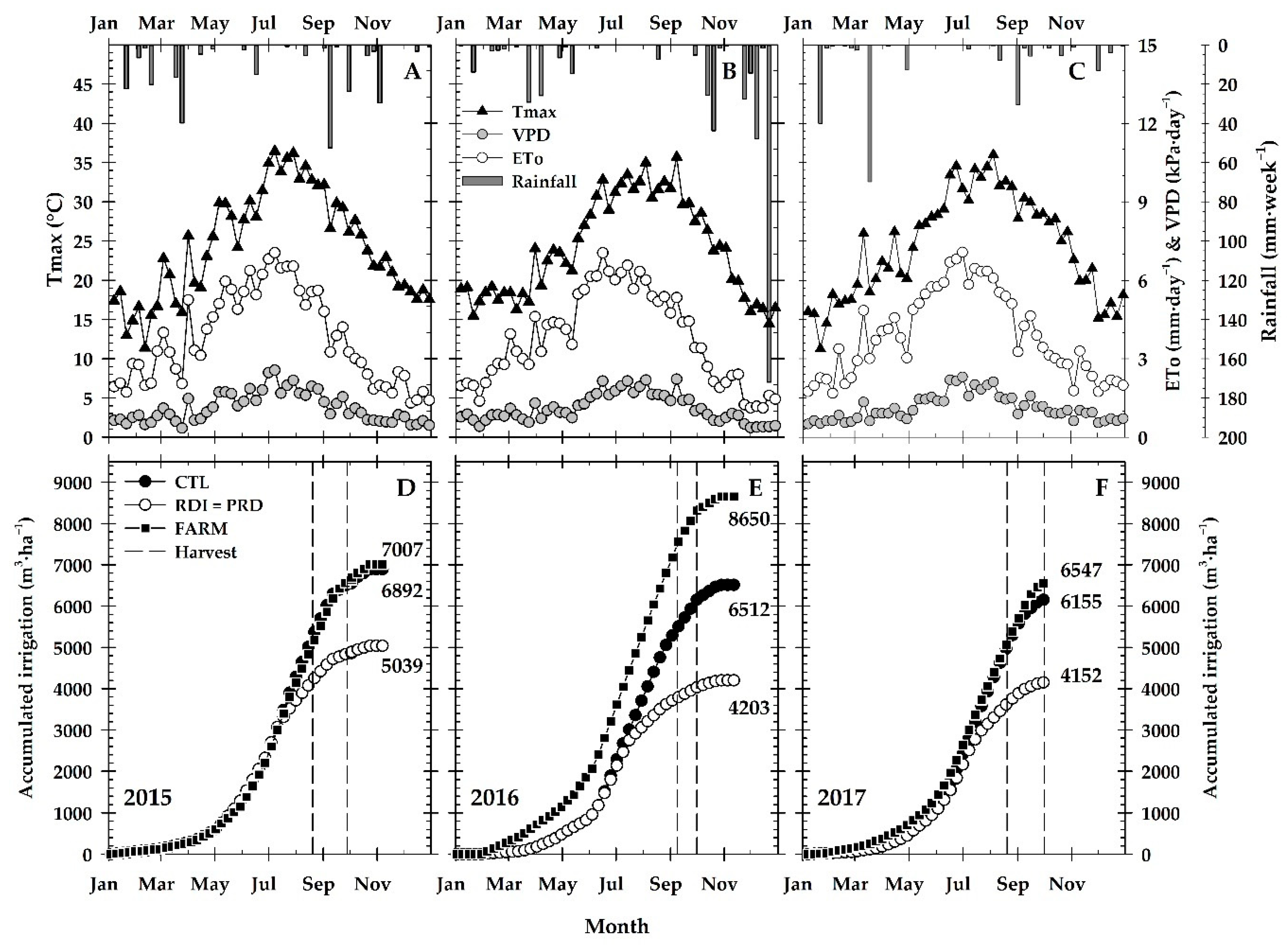

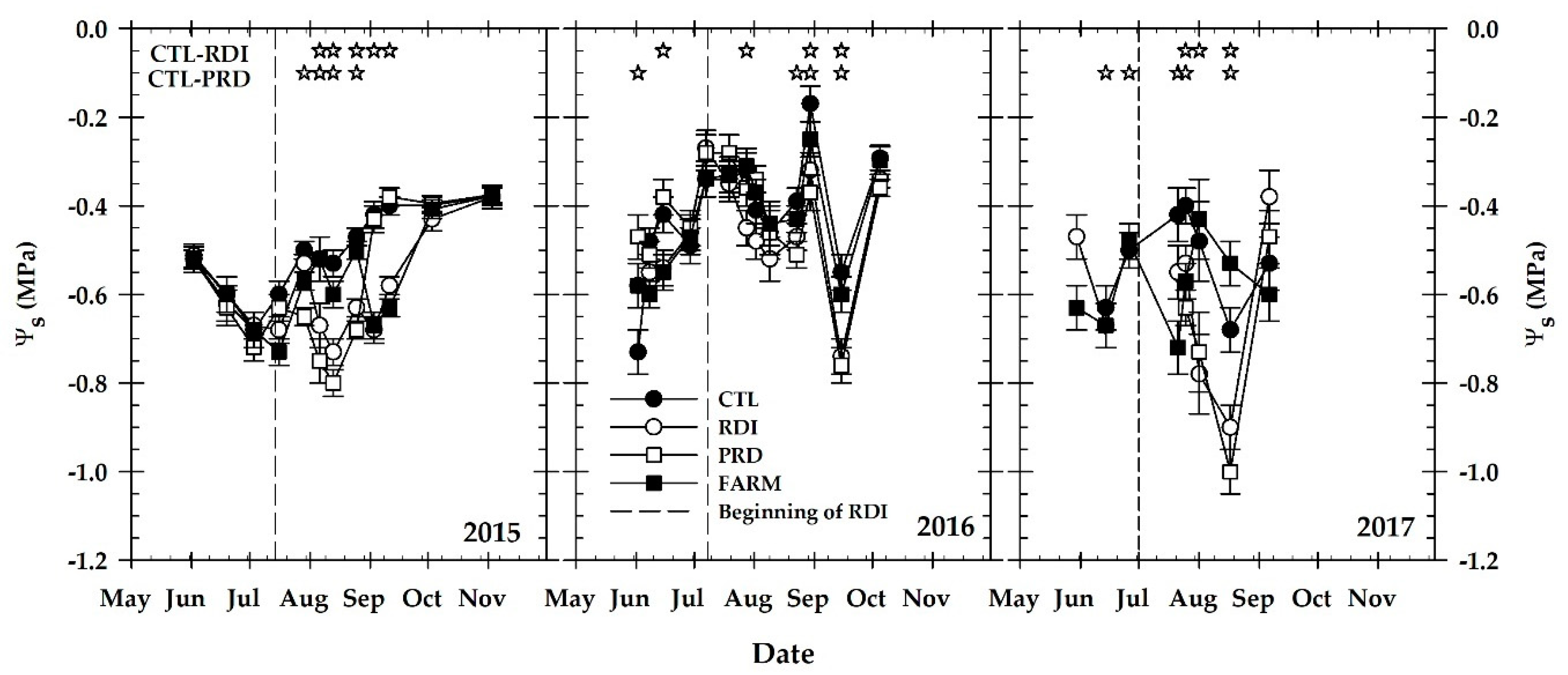
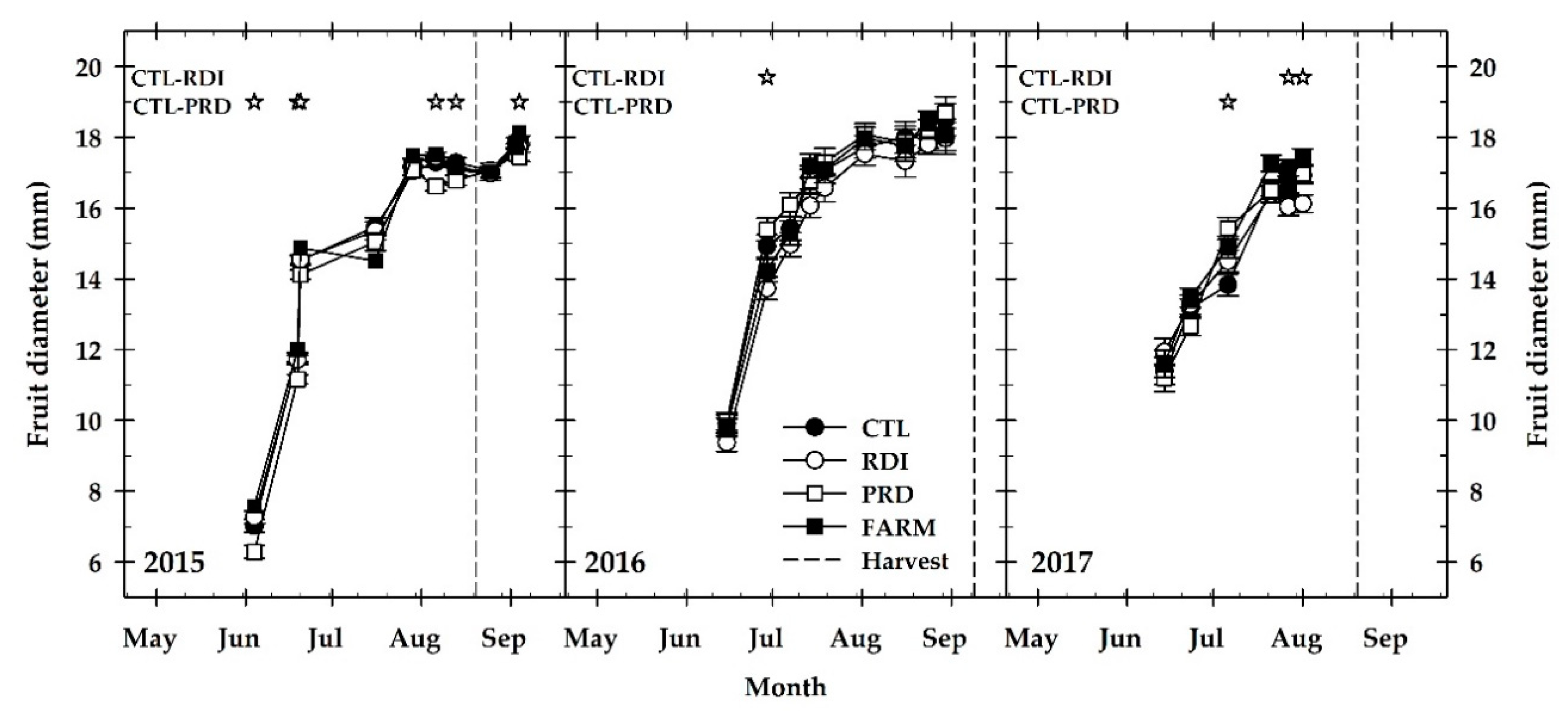
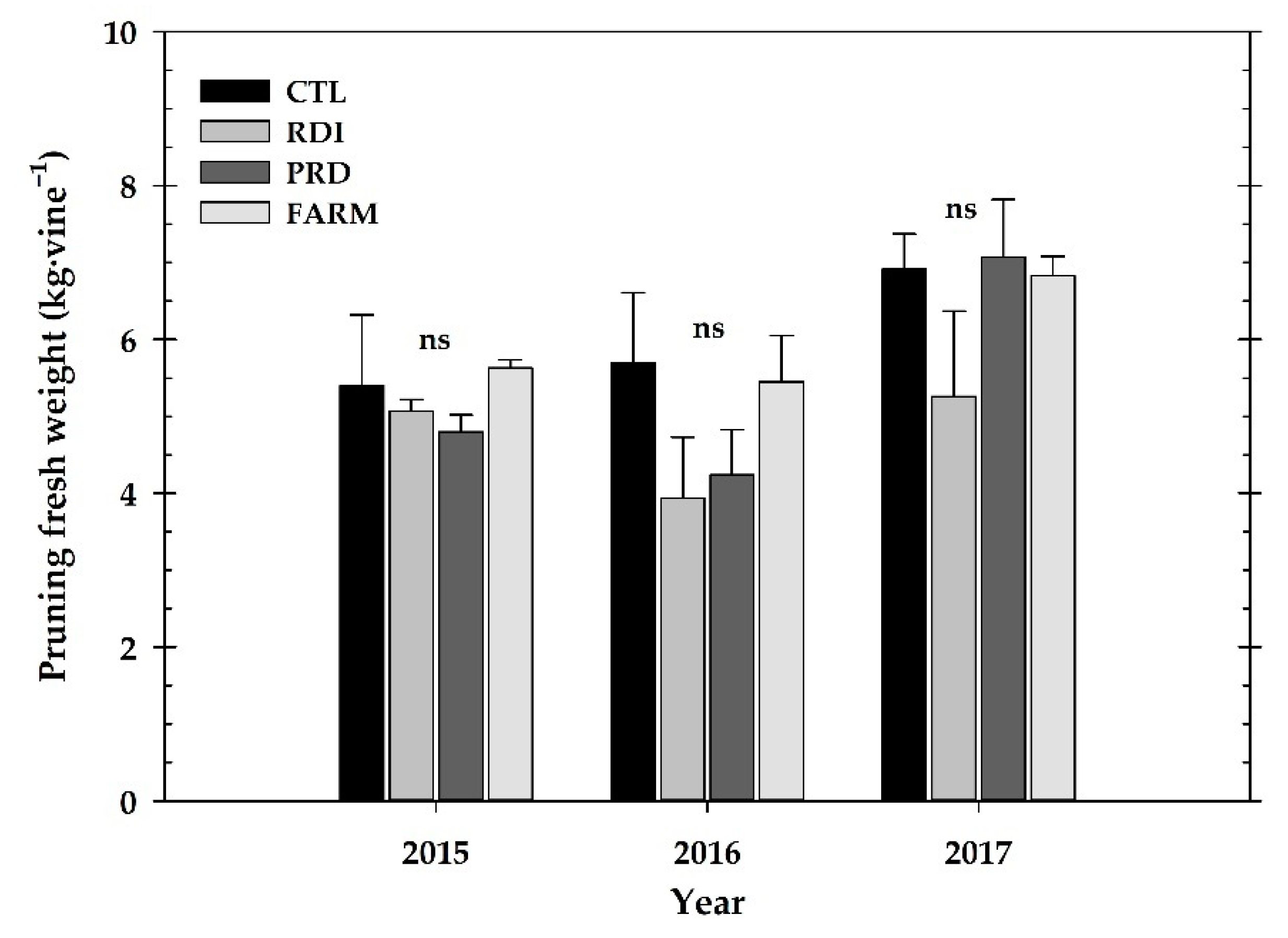
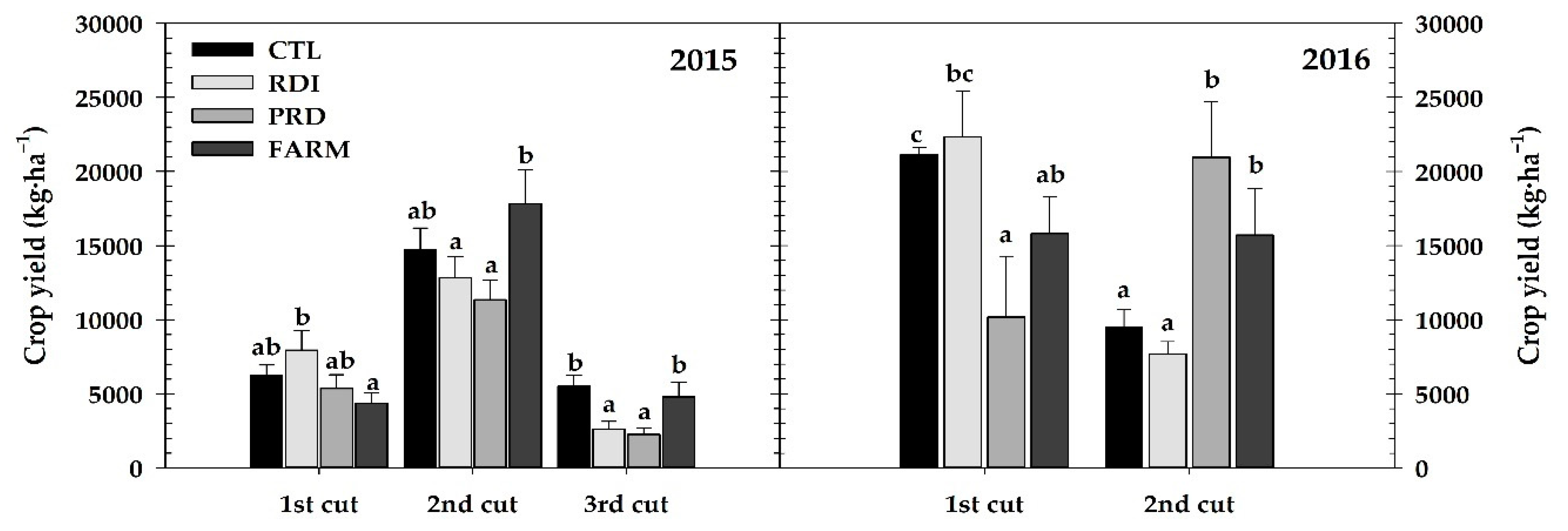
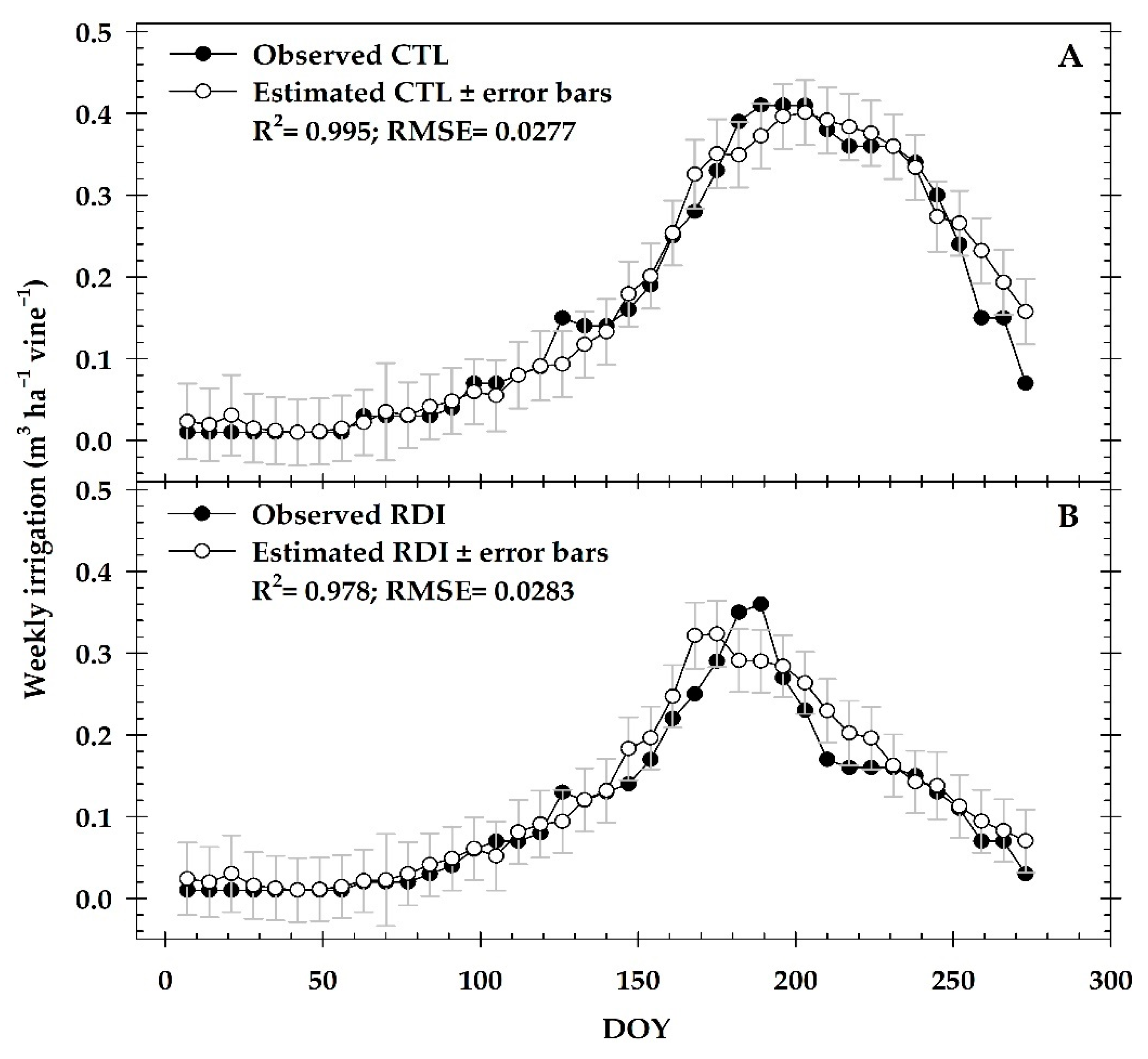
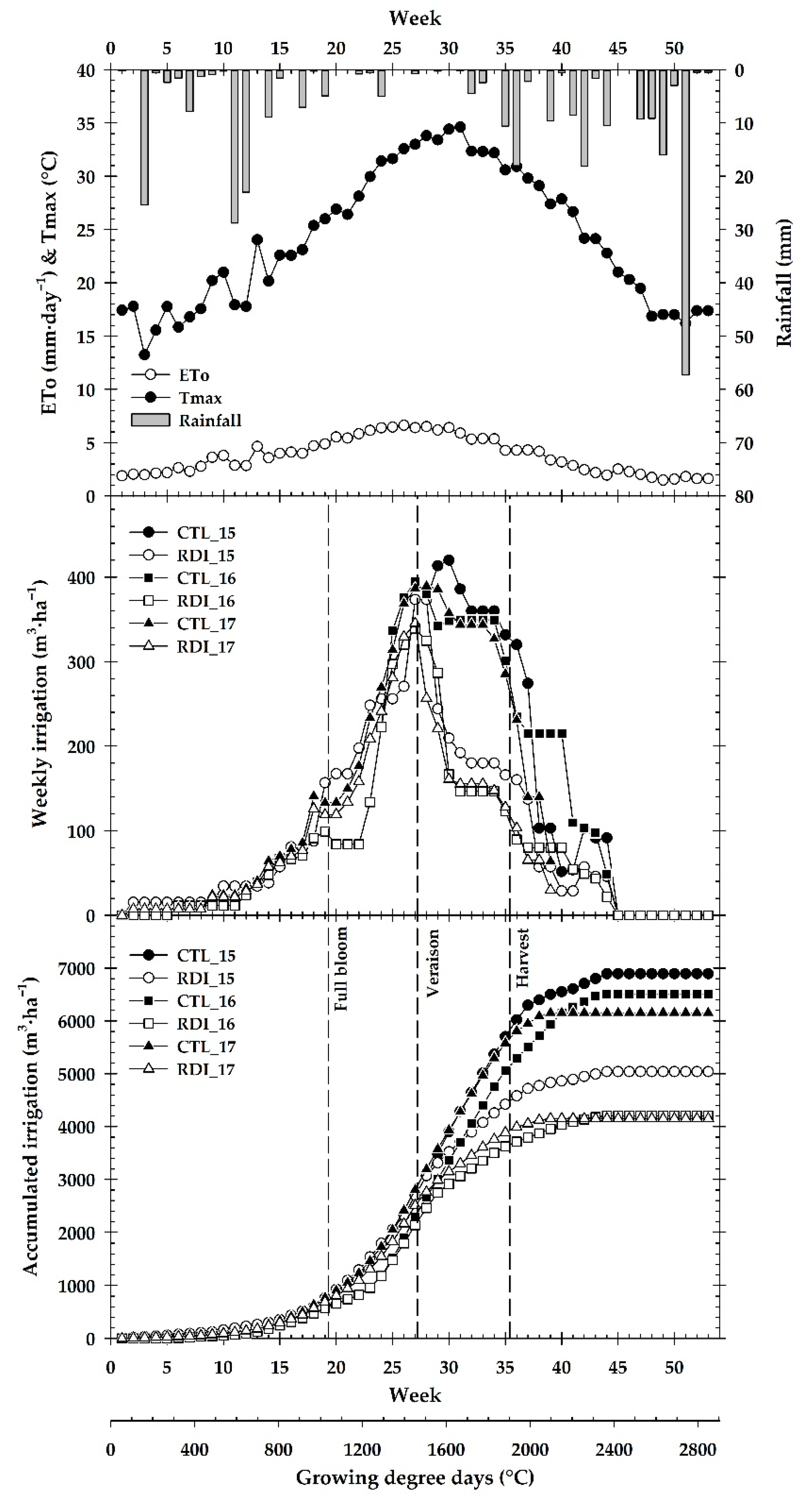
| Year /Treatment | Total Yield (kg·Vine−1) | Number of Clusters (Clusters·Vine−1) | Number of Berries (Berries·Clusters−1) | Mean Weight of Clusters (g) | Mean Weight of Berries (g) |
|---|---|---|---|---|---|
| 2015 | |||||
| CTL | 19.76 ± 5.28 a | 57.4 ± 13.6 a | 66.51 ± 4.94 ab | 344.25 ± 19.58 ab | 5.09 ± 0.11 a |
| RDI | 21.63 ± 7.41 a | 58.6 ± 24.6 a | 82.61 ± 4.41 c | 369.11 ± 29.29 b | 4.73 ± 0.22 a |
| PRD | 13.7 ± 1.51 a | 49.0 ± 6.5 a | 60.07 ± 4.07 ab | 279.59 ± 14.17 a | 4.71 ± 0.09 a |
| FARM | 25.29 ± 7.49 a | 67.6 ± 18.4 a | 77.14 ± 3.37 bc | 374.11 ± 16.73 b | 4.81 ± 0.04 a |
| 2016 | |||||
| CTL | 32.2 ± 2.4 a | 41.5 ± 2.1 a | 148.55 ± 7.91 b | 775.90 ± 41.6 b | 5.25 ± 0.19 a |
| RDI | 31.5 ± 2.5 a | 53.5 ± 6.0 a | 108.79 ± 4.65 a | 588.79 ± 25.2 a | 5.43 ± 0.29 a |
| PRD | 32.7 ± 2.4 a | 56.3 ± 6.0 a | 95.69 ± 3.991 a | 580.81 ± 23.7 a | 6.07 ± 0.28 a |
| FARM | 33.1 ± 2.4 a | 57.4 ± 5.5 a | 105.35 ± 1.53 a | 576.66 ± 8.35 a | 5.48 ± 0.46 a |
| 2017 | |||||
| CTL | 16.6 ± 2.68 a | 37.4 ± 5.9 a | 106.92 ± 6.03 a | 443.85 ± 38.76 a | 4.21 ± 0.14 a |
| RDI | 20.31 ± 7.2 a | 50.8 ± 18.9 a | 100.45 ± 7.29 a | 399.80 ± 24.55 a | 4.16 ± 0.15 a |
| PRD | 22.75 ± 4.02 a | 55.7 ± 9.7 a | 91.78 ± 5.32 a | 408.44 ± 7.51 a | 4.49 ± 0.33 a |
| FARM | 18.61 ± 1.41 a | 43.3 ± 2.8 a | 114.88 ± 10.06 a | 429.79 ± 19.23 a | 3.87 ± 0.30 a |
| Treatment (T) | ns | ns | *** | *** | ns |
| Year (y) | *** | ns | *** | *** | *** |
| T × y | ns | ns | *** | *** | *** |
| Year/Treatment | Total Soluble Solids (°Brix) | Titratable Acidity (g L−1) | Maturity Index (MI) |
|---|---|---|---|
| 2015 | |||
| CTL | 17.6 ± 0.2 a | 4.5 ± 0.2 a | 40.0 ± 1.7 a |
| RDI | 17.8 ± 0.2 a | 4.2 ± 0.1 a | 43.6 ± 1.4 a |
| PRD | 17.8 ± 0.2 a | 4.4 ± 0.2 a | 41.7 ± 1.8 a |
| FARM | 17.7 ± 0.2 a | 4.5 ± 0.2 a | 40.6 ± 1.7 a |
| 2016 | |||
| CTL | 17.5 ± 0.3 a | 3.5 ± 0.2 a | 50.2 ± 3.0 a |
| RDI | 17.5 ± 0.5 a | 3.4 ± 0.0 a | 51.8 ± 2.3 a |
| PRD | 17.1 ± 0.3 a | 3.6 ± 0.2 a | 47.6 ± 1.6 a |
| FARM | 17.3 ± 0.4 a | 3.6 ± 0.1 a | 48.1 ± 0.2 a |
| 2017 | |||
| CTL | 18.8 ± 0.3 a | 3.3 ± 0.3 ab | 57.5 ± 3.8 ab |
| RDI | 19.2 ± 0.4 a | 2.9 ± 0.1 a | 66.4 ± 3.6 b |
| PRD | 18.9 ± 0.1 a | 3.1 ± 0.0 ab | 60.3 ± 0.7 ab |
| FARM | 19.0 ± 0.3 a | 3.5 ± 0.1 b | 54.4 ± 2.7 a |
| Treatment (T) | ns | * | *** |
| Year (y) | *** | *** | *** |
| T × y | ns | ns | ns |
Publisher’s Note: MDPI stays neutral with regard to jurisdictional claims in published maps and institutional affiliations. |
© 2020 by the authors. Licensee MDPI, Basel, Switzerland. This article is an open access article distributed under the terms and conditions of the Creative Commons Attribution (CC BY) license (http://creativecommons.org/licenses/by/4.0/).
Share and Cite
Temnani, A.; Conesa, M.R.; Ruiz, M.; López, J.A.; Berríos, P.; Pérez-Pastor, A. Irrigation Protocols in Different Water Availability Scenarios for ‘Crimson Seedless’ Table Grapes under Mediterranean Semi-Arid Conditions. Water 2021, 13, 22. https://doi.org/10.3390/w13010022
Temnani A, Conesa MR, Ruiz M, López JA, Berríos P, Pérez-Pastor A. Irrigation Protocols in Different Water Availability Scenarios for ‘Crimson Seedless’ Table Grapes under Mediterranean Semi-Arid Conditions. Water. 2021; 13(1):22. https://doi.org/10.3390/w13010022
Chicago/Turabian StyleTemnani, Abdelmalek, María R. Conesa, Manuel Ruiz, Juan A. López, Pablo Berríos, and Alejandro Pérez-Pastor. 2021. "Irrigation Protocols in Different Water Availability Scenarios for ‘Crimson Seedless’ Table Grapes under Mediterranean Semi-Arid Conditions" Water 13, no. 1: 22. https://doi.org/10.3390/w13010022
APA StyleTemnani, A., Conesa, M. R., Ruiz, M., López, J. A., Berríos, P., & Pérez-Pastor, A. (2021). Irrigation Protocols in Different Water Availability Scenarios for ‘Crimson Seedless’ Table Grapes under Mediterranean Semi-Arid Conditions. Water, 13(1), 22. https://doi.org/10.3390/w13010022








